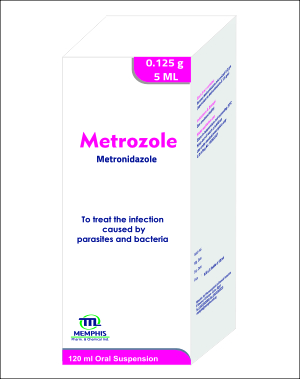TRADE NAME: METROZOLE GENERIC NAME: Benzoyl metronidazole COMPOSITION: Each 5 ml contains: Active ingredient: Benzoyl metronidazole micronized 200mg (equivalent to metronidazole 125mg/5ml) : Excipients Avicel RC591, Carboxyl methyl cellulose sodium, Sorbitol solution 70%, Glycerol, Methyl paraben, probyl paraben, Polysorbate 80 (tween80), Saccharin sodium, Lemon oil, Sodium hydrogen phosphate monohydrate, Deionized water. PHARMACEUTICAL FORM: Oral suspension. PHARMACOLOGICAL ACTION: PHARMACODYNAMICS: Pharmacotherapeutic group: imidazole derivatives. Metronidazole is an anti – infective of the family of 5 nitro- imidazoles. Its antibacterial spectrum is the following: - Usually sensitive species (more than 90% of the strains are sensitive): Peptostreptococcus, Clostridium perfringens, Clostridium Difficile, Clostridium spp.; Bacteroides fragilis, Bacteroides spp., Prevotella, Fusobacterium, Veillonella. - Resistant species (at least 50% of the strains are resistant): Propinebacterium, Actinomyces, Mobiluncus. - Inconstantly sensitive species (the percentage of resistance is variable, the sensitivity is unpredictable if an antibiogram is not done): Bifidobacterium, Eubacterium. Antiparasitic activity: Entamoeba histolytica, Trichomonas vaginalis, Giardia intestinalis. PHARMACOKINETICS: Absorption After oral administration, metronidazole is rapidly absorbed, at least 80% in 1 hour. The serum peaks obtained after oral administration are similar to those obtained after intravenous administration of doses equivalents. The oral bioavailability is 100% and is not greatly affected by the simultaneous ingestion of food. The plasma half-life is 8 to 10 hours. The plasma protein binding is less than 20%. Biotransformation Metronidazole metabolizes by the liver, being the major metabolite hydroxy-metronidazole (HM), whose activity is between 30 - 65% of the activity of metronidazole. Elimination The kidney is the main route of elimination for metronidazole and its metabolites. The urinary excursion practice involves removing the administered dose. The serum concentration of metronidazole is not significantly affected by renal failure, increasing the plasma concentrations of metabolites, some of which are practically undetectable in subjects with normal renal function. The relationship between the accumulation of metabolites and the eventual occurrence of adverse reactions is not known, so the dose reduction of metronidazole can be recommended. in patients with renal insufficiency, when they are not undergoing dialysis and monitoring the serum levels of the metabolites. INDICATIONS: Metronidazole is indicated in adults and children for the following indications: Lambliasis. Intestinal and hepatic amebiasis Treatment of anaerobic infections, due to Bacteroides fragilis, Clostridium perfringens and other anaerobic bacteria Trichomonas infections (urethritis, vaginitis). The official recommendations regarding the proper use of antibacterial agents should be taken into account. DOSAGE AND ADMINISTRATION: Orally. A small teaspoon is equivalent to 5 ml. Each 5 ml contains 125 mg of metronidazole. Lambliasis (Giardiasis): Older than 10 years: 2,000 mg once a day for 3 days, or 400 mg three times a day for 5 days, or 500 mg twice a day for 7-10 days. Children from 7 to 10 years old: 1,000 mg once a day for 3 days. Children from 3 to 7 years old: from 600 to 800 mg once a day for 3 days. Children from 1 to 3 years old: 500 mg once a day for 3 days. Or, expressed in mg per kilogram of body weight: 15-40 mg / kg / day divided into 2-3 doses. Amebiasis: Over 10 years: 400 to 800 mg 3 times a day for 5-10 days. Children from 7 to 10 years old: from 200 to 400 mg 3 times a day for 5-10 days. Children from 3 to 7 years old: from 100 to 200 mg 4 times a day for 5-10 days. Children from 1 to 3 years old: from 100 to 200 mg 3 times a day for 5-10 days. Or, the doses can be expressed by body weight: from 35 to 50 mg / kg per day divided into 3 doses for 5 - 10 days, not exceeding the dose of 2,400 mg / day. Anaerobic infections: Adults: 500 mg every 8 hours. Children older than 8 weeks up to 12 years of age: The usual daily dose is 20-30 mg / kg / day as a single dose or divided into 7.5 mg / kg every 8 hours. The daily dose could be increased to 40 mg / kg, depending on the severity of the infection. The duration of the treatment is generally 7 days. Children under 8 weeks: 15 mg / kg as a single daily dose or divided into 7.5 mg / kg every 12 hours. In newborns with a gestational period of less than 40 weeks, an accumulation of metronidazole may occur during the first week of life, therefore, plasma concentrations of metronidazole should preferably be monitored after a few days of treatment. Trichomonas Infections: Urogenital trichomoniasis: Adults and adolescents: 2,000 mg as a single dose, or 200 mg 3 times a day for 7 days or 400 mg twice a day for 5-7 days. Children under 10 years: 40 mg / kg orally as a single dose or 15-30 mg / kg / day divided into 2-3 doses for 7 days; the dose should not exceed 2,000 mg. Bacterial vaginosis: Adolescents: 400 mg twice daily for 5-7 days or 2,000 mg as a single dose. Whether or not the couple has clinical signs of Trichomonas infection vaginalis, it is necessary that it be treated concurrently, even in the absence of positive response from laboratory.
